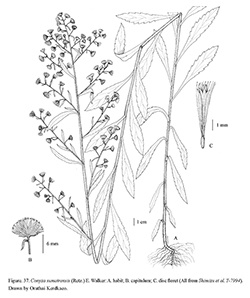e-Flora of Thailand
Volume 13 > Part 2 > Year 2016 > Page 254 > Compositae (Asteraceae) > Conyza
5. Conyza sumatrensis (Retz.) E.Walkerwfo-0000084660
J. Jap. Bot. 46: 72. 1971; Kitam. & Gould in Hara, Chater & Williams, ed., Enum. Fl. Pl. Nepal 3: 21. 1982; H.Koyama, Acta Phytotax. Geobot. 34: 7. 1983; Chen, Fl. Reipubl. Popularis Sin. 74: 350. 1985; Grierson & D.G.Long, Fl. Bhutan 2(3): 1544. 2001. Fig. 37.
Accepted Name : Erigeron sumatrensis Retz.
Observ. Bot. 5: 28. 1788; Ridl., Fl. Malay Penins. 2: 196. 1923; Kerr, Fl. Siam. 2(3): 254. 1936; Backer & Bakh.f., Fl. Java 1: 385. 1965; J.Kost., Nova Guinea Bot. 24: 560. 1966; Y.L.Chen & Brouillet, Fl. China 20–21: 649. 2011.
Synonyms & Citations :
Description : Annual herb, 0.5–1.5 m tall; stems erect, from tap roots, greyish green, coarsely long hirsute and short pilose, branched above, branches ending in inflorescences. Leaves basal and cauline; basal leaves usually withering before flowering, oblanceolate, 6–10 by 1.5–3 cm, apex acute, base narrowed to petiole, margins coarsely few toothed; median cauline leaves narrowly oblanceolate, 3–8 by 0.5–10 mm, apex gradually acute or acuminate; upper leaves gradually smaller, narrowly oblanceolate to linear, margins entire, hirtellous. Inflorescences pyramidal panicles; peduncles slender, 5–15 mm long; bracteoles 1–3, linear. Capitula radiate; involucres campanulate, 5–7 by 4–6 mm; phyllaries 3-seriate, imbricate, outer 1–2 mm long, linear, inner linear-lanceolate, with scarious margins, abaxial surface pilose; receptacle slightly fimbrillate. Marginal florets many per capitulum, 3- or 4-seriate; corollas filiform, basal tube slender, rays inconspicuous, pale violet. Disc florets ca 10 per capitulum; corollas tubular, yellow, ca 3.8 mm long, apex 5-lobed. Achenes oblong, ca 1.5 mm long, compressed, setuliferous; pappus of capillary bristles 3.5–4 mm long, brownish white.
Thailand : NORTHERN: Chiang Mai (Sop Ap to Pha Mon, Doi Suthep, Doi Chang, Doi Chiang Dao, Wang Tao, Pha Hom Pok), Chiang Rai (Ban San Sa At), Lampang (16 km N of Tak), Phitsanulok (Thung Salaeng Luang NP), Tak (Lansang NP, Ban Musoe); NORTH-EASTERN: Loei (Phu Kradueng, Phu Luang); EASTERN: Chaiyaphum (Nam Phrom to Thung Kramang); SOUTH-WESTERN: Prachuap Khiri Khan (Bang Saphan); CENTRAL: Saraburi (to Pak Chong); Nakhon Nayok (Khao Yai NP); SOUTH-EASTERN: Trat (Ko Chang); PENINSULAR: Ranong (Khao Pota Luang Kaeo), Surat Thani (Chong Lom), Trang (Khao Chong Botanic Garden).
Distribution : Native from E Asian tropics (Sumatra – type), Malaysia northward Japan.
Ecology : On soils derived from limestones and sandstones in deciduous forests, bamboo thickets to open hill evergreen forests with pines-oaks, 0–1,900 m alt. Flowering all year round.
Notes: This species has been considered to be a native of South America (e.g., Kitamura, 1969; Grierson, 1980). Preliminary examination of specimens reveals that South American specimens are distinguished from the Asian ones by the glabrate habit of whole plants.

